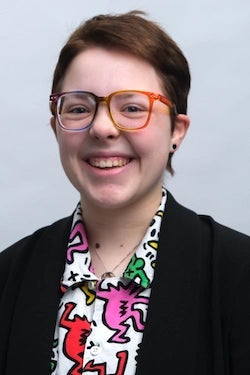Undergraduate Research
Cecil Pulley '24

Cecil Pulley (he/they) is a Mellon Mays Undergraduate Fellow majoring in Art History and GSFS conducts mentored research under Professor Christina Neilson. Their project is titled “Intersections of Queerness & Christianity in the Art, Life & Legacy of Keith Haring".
Please describe your project:
My project explores the intersections between queer and Christian iconography and identity in the art, life and legacy of 80s pop artist Keith Haring. Using visual analysis, I am exploring the symbols and subject matter of Haring’s artwork from a lens that closely considers his Christian upbringing and queer identity, reconsidering the meaning of his work with close readings of his journals and biography. This has allowed me to propose new interpretations of Haring’s work that brings his identity into conversation, as well as pose questions about Haring’s role within power structures of race, class and gender. Currently, I am using a painting of Haring’s to explore how both critics and Haring himself positioned the artist as saint-like, playing upon art historical tropes of the “divine artist”.
Please include a brief summary (the elevator speech) of your research project:
My project explores the intersections between queerness and Christianity in the art, life and legacy of 80s pop artist Keith Haring, using visual analyses of selected works and close readings of Haring’s journal and biography. I seek to explore and critique how Haring’s experiences have been represented by critics following his death, and how his identity positions him within power structures of gender, race and class.
Why is your research important?
I think my research is important not only because it fills a gap in (and offers critiques of) existing study of Keith Haring and his work, but also exemplifies a cross-disciplinary approach that can be applied in both art history research and broader media studies.
What knowledge has your research contributed to your field?
Through my research I’ve been able to offer multifaceted analyses of two of Haring’s works, The Ten Commandments and St. Sebastian, that are unique in their interpretations and level of depth. I’ve found links between how Haring connects Christian and Queer themes through dehumanization and masculinized sexuality, and also investiagted Haring’s flawed understanding and visual representations of oppression.
In what ways have you showcased your research?
I gave a presentation at the Oberlin Summer Research Institute, and as I’m writing this I am also preparing for the Mellon Mays conference that's during Fall Break!
How did you get involved in research?
I did AP Research in high school which really inspired me to pursue it at Oberlin. I’ve also been involved in a lot of classes at Oberlin that involved solo research assignments, one of which I was encouraged to elaborate upon during Winter Term, which is how I started working closely with my faculty mentor for my MMUF project.
What is your favorite aspect of the research process?
Keith Haring is my favorite artist, so I really love my topic and getting to look at some of my all-time favorite works of art (and sharing them with others!) I’ve also really enjoyed working with my mentor and the folks at the art museum! The Allen currently has a few of Haring’s works in their collection that I’ve gotten to go and see in person, which is really fun.
How has working with your mentor impacted the development of your research project? How has it impacted you as a researcher?
Working with Professor Neilson is the best because she always poses the perfect amount of challenge– she knows how to push me to think in new directions and is also the best at close-reading things and helping me with writing and revising. She doesn’t specialize in modern art, but her perspective on the intersections of art and religion is really insightful for my project, specifically (she also gives great book recommendations!)
What advice would you give to a younger student wanting to get involved in research in your field?
Use! Those! Facilities! If you’re interested in doing object study work specifically, start with items at the Allen and in their collections! There’s a real treasure trove of stuff there to kick-start research work and let you dip your toe into research with the department. Schedule some time in the Print Study room… that place is seriously the best (I’ve gotten to stand face to face with art that's over 500 years old!) I also highly recommend spending some time getting familiar with all the great rsources the Art Library has to offer!